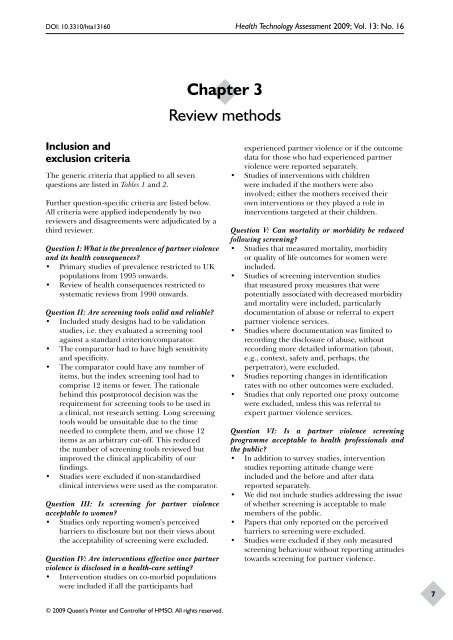How far does screening women for domestic (partner) - NIHR Health ...
How far does screening women for domestic (partner) - NIHR Health ...
How far does screening women for domestic (partner) - NIHR Health ...
Create successful ePaper yourself
Turn your PDF publications into a flip-book with our unique Google optimized e-Paper software.
DOI: 10.3310/hta13160 <strong>Health</strong> Technology Assessment 2009; Vol. 13: No. 16<br />
Inclusion and<br />
exclusion criteria<br />
The generic criteria that applied to all seven<br />
questions are listed in Tables 1 and 2.<br />
Further question-specific criteria are listed below.<br />
All criteria were applied independently by two<br />
reviewers and disagreements were adjudicated by a<br />
third reviewer.<br />
Question I: What is the prevalence of <strong>partner</strong> violence<br />
and its health consequences?<br />
• Primary studies of prevalence restricted to UK<br />
populations from 1995 onwards.<br />
• Review of health consequences restricted to<br />
systematic reviews from 1990 onwards.<br />
Question II: Are <strong>screening</strong> tools valid and reliable?<br />
• Included study designs had to be validation<br />
studies, i.e. they evaluated a <strong>screening</strong> tool<br />
against a standard criterion/comparator.<br />
• The comparator had to have high sensitivity<br />
and specificity.<br />
• The comparator could have any number of<br />
items, but the index <strong>screening</strong> tool had to<br />
comprise 12 items or fewer. The rationale<br />
behind this postprotocol decision was the<br />
requirement <strong>for</strong> <strong>screening</strong> tools to be used in<br />
a clinical, not research setting. Long <strong>screening</strong><br />
tools would be unsuitable due to the time<br />
needed to complete them, and we chose 12<br />
items as an arbitrary cut-off. This reduced<br />
the number of <strong>screening</strong> tools reviewed but<br />
improved the clinical applicability of our<br />
findings.<br />
• Studies were excluded if non-standardised<br />
clinical interviews were used as the comparator.<br />
Question III: Is <strong>screening</strong> <strong>for</strong> <strong>partner</strong> violence<br />
acceptable to <strong>women</strong>?<br />
• Studies only reporting <strong>women</strong>’s perceived<br />
barriers to disclosure but not their views about<br />
the acceptability of <strong>screening</strong> were excluded.<br />
Question IV: Are interventions effective once <strong>partner</strong><br />
violence is disclosed in a health-care setting?<br />
• Intervention studies on co-morbid populations<br />
were included if all the participants had<br />
© 2009 Queen’s Printer and Controller of HMSO. All rights reserved.<br />
Chapter 3<br />
Review methods<br />
experienced <strong>partner</strong> violence or if the outcome<br />
data <strong>for</strong> those who had experienced <strong>partner</strong><br />
violence were reported separately.<br />
• Studies of interventions with children<br />
were included if the mothers were also<br />
involved; either the mothers received their<br />
own interventions or they played a role in<br />
interventions targeted at their children.<br />
Question V: Can mortality or morbidity be reduced<br />
following <strong>screening</strong>?<br />
• Studies that measured mortality, morbidity<br />
or quality of life outcomes <strong>for</strong> <strong>women</strong> were<br />
included.<br />
• Studies of <strong>screening</strong> intervention studies<br />
that measured proxy measures that were<br />
potentially associated with decreased morbidity<br />
and mortality were included, particularly<br />
documentation of abuse or referral to expert<br />
<strong>partner</strong> violence services.<br />
• Studies where documentation was limited to<br />
recording the disclosure of abuse, without<br />
recording more detailed in<strong>for</strong>mation (about,<br />
e.g., context, safety and, perhaps, the<br />
perpetrator), were excluded.<br />
• Studies reporting changes in identification<br />
rates with no other outcomes were excluded.<br />
• Studies that only reported one proxy outcome<br />
were excluded, unless this was referral to<br />
expert <strong>partner</strong> violence services.<br />
Question VI: Is a <strong>partner</strong> violence <strong>screening</strong><br />
programme acceptable to health professionals and<br />
the public?<br />
• In addition to survey studies, intervention<br />
studies reporting attitude change were<br />
included and the be<strong>for</strong>e and after data<br />
reported separately.<br />
• We did not include studies addressing the issue<br />
of whether <strong>screening</strong> is acceptable to male<br />
members of the public.<br />
• Papers that only reported on the perceived<br />
barriers to <strong>screening</strong> were excluded.<br />
• Studies were excluded if they only measured<br />
<strong>screening</strong> behaviour without reporting attitudes<br />
towards <strong>screening</strong> <strong>for</strong> <strong>partner</strong> violence.<br />
7
















